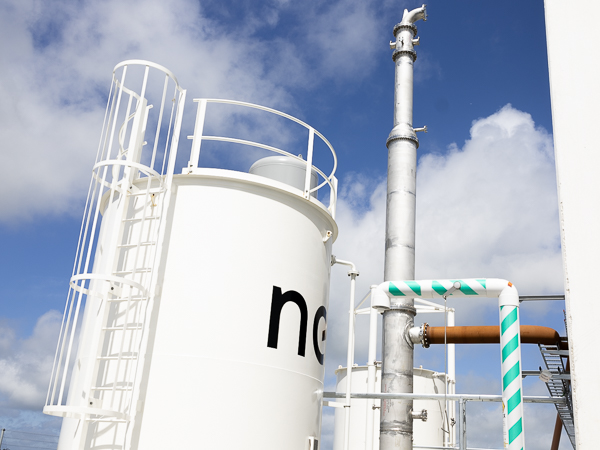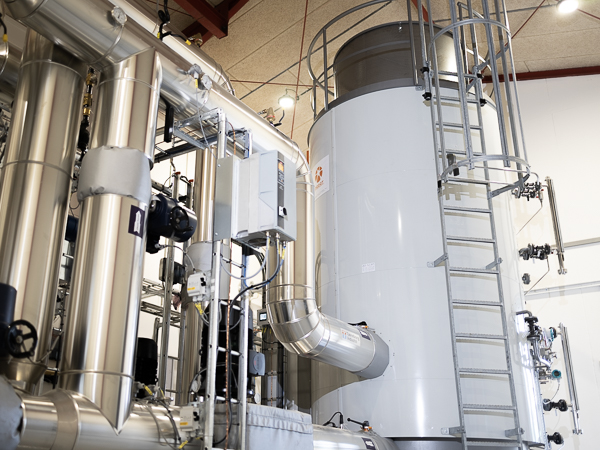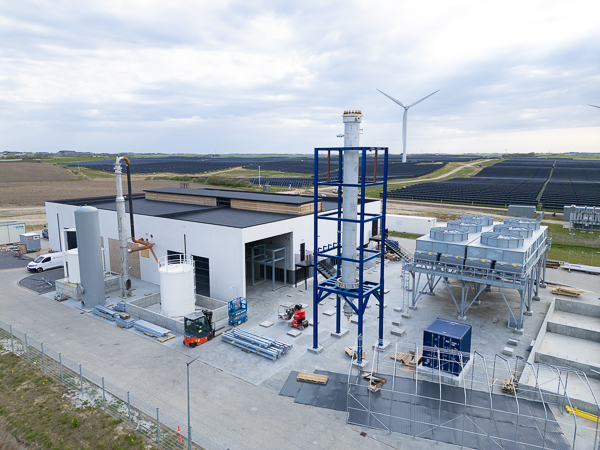An in-depth explanation of Power to X
Power to X (PtX) technology has gained considerable attention as a potential solution to decarbonize the energy system and combat climate change. This blog post provides an in-depth analysis of Power to X, examining its principles, technological processes, benefits, applications, future prospects, and the challenges to be overcome.

Ammonia scrubber plant at the Power to X plant in Ramme near Lemvig, Denmark
What does Power to X mean?
"Power to X" is a term that refers to technologies that convert electrical energy (Power) into other forms of energy or chemicals (X). By harnessing excess electricity from renewable sources such as wind and solar, PtX can enable the efficient storage and use of clean energy when it is most needed. If you want to know more about one of the most innovative and exciting technologies, you should read the article Power to X - how to produce green ammonia.
Power to X plant
The heart of Power to X is electrolysis, a process that uses electricity to split water molecules (H2O) into hydrogen (H2) and oxygen (O2). The hydrogen produced can then be converted into various forms of energy or chemicals. The most common Power to X variants include:
- Power to Gas (PtG): Converts hydrogen into gaseous fuels such as hydrogen gas (H2) or methane (CH4).
- Power to Liquid (PtL): Produces liquid fuels such as synthetic diesel or kerosene using processes such as Fischer-Tropsch synthesis.
- Power to Heat (PtH): Electrode boilers convert electricity directly into heat that can be used in district heating systems or industrial processes.
Advantages of Power to X
Power to X tilbyder en række fordele, der gør det til en attraktiv løsning for en bæredygtig fremtid:
- Energiforsyningssikkerhed: Lagrer vedvarende energi i form af brint eller andre energibærere, der kan bruges til at supplere forsyningen, når vedvarende energikilder ikke er tilgængelige.
- Sektorkobling: Integrerer forskellige energisektorer, f.eks. el, transport og varme, og øger dermed systemets fleksibilitet og effektivitet.
- Dekarbonisering: Muliggør produktion af CO2-neutrale brændstoffer og kemikalier, der reducerer drivhusgasemissioner og bidrager til at nå klimamålene.
Uses of Power to X
Power to X offers a number of advantages that make it an attractive solution for a sustainable future:
- Security of energy supply: Stores renewable energy in the form of hydrogen or other energy carriers that can be used to supplement the supply when renewable energy sources are not available.
- Sector coupling: Integrates different energy sectors, e.g. electricity, transport and heat, thus increasing the system's flexibility and efficiency.
- Decarbonisation: Enables the production of CO2-neutral fuels and chemicals that reduce greenhouse gas emissions and contribute to achieving climate goals.

Prepared electrode boiler installed at Bramming Fjernvarme
Uses of Power to X
Power to X technologies have a wide range of applications. In the transport sector, synthetic fuels can replace fossil fuels in aircraft, ships and heavy transport where electrification is challenging. Industry can benefit from Power to X products as raw materials that enable the sustainable production of plastics and other materials. In heat supply, Power to Heat solutions can be integrated into district heating networks, increasing the use of renewable energy and reducing dependence on fossil fuels.
- Transport: Synthetic fuels can replace fossil fuels in aircraft, ships and heavy transport where electrification is challenging.
- Industry: PtX products can be used as raw materials in the chemical industry, enabling the sustainable production of plastics and other materials.
- Heat supply: Power-to-Heat solutions can be integrated into district heating networks, increasing the use of renewable energy.
The future of Power to X
With the increasing focus on sustainability and climate goals, PtX plays a decisive role in achieving a fully integrated and green energy infrastructure. Innovation and investments in PtX technologies will be decisive for future energy systems.

Power to ammonia plant under construction with attached large solar park and wind turbines.
Challenges and future prospects
Although Power to X has great potential, there are also challenges that need to be addressed:
- Costs: Production costs for hydrogen and synthetic fuels remain relatively high compared to fossil fuels.
- Infrastructure: Extensive infrastructure investment is required to support the production, storage and distribution of PtX fuels.
- Politics and economics: Political support and incentives are essential to promote the spread of Power to X technologies.
Conclusion
Power to X represents a ground-breaking technology with the potential to transform the energy system and contribute to a more sustainable future. Although there are still challenges to be overcome, Power to X technologies are a promising alternative to fossil fuels and an important part of the solution to climate challenges.

